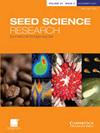Beetroot and spinach seed microbiomes can suppress Pythium ultimum infection: results from a large-scale screening
IF 2.1
3区 生物学
Q2 PLANT SCIENCES
引用次数: 1
Abstract
Abstract Seed health is an indispensable prerequisite of food security. While the toolkit of plant protection products is currently limited, evidence suggests that the seed microbiome could protect seeds from pathogens. Thus, given their possible disease suppressive potential, we tested 11 different pathosystems to achieve the following proof-of-concept: seed microbiomes can be beneficial for seed health through conferring disease suppression. This study focused on beetroot, onion, spinach, pepper, coriander, red fescue and perennial ryegrass seeds, with each crop being challenged with one or two from a total of six pathogens, namely Pythium ultimum (or a Pythium sp.), Setophoma terrestris, Fusarium oxysporum, Phytophthora capsici, Laetisaria fuciformis and a mix of Puccinia sp. isolates. Each seed lot of each crop was tested with and without treatment with a disinfectant as a proxy for comparing intact seed microbiomes with seed microbiomes after partial elimination by disinfection. We found disease suppression in two pathosystems. Beetroot and spinach seed lots were able to suppress disease caused by P. ultimum when their microbiomes were intact but not after seed disinfection. We speculate that this relates to the microorganisms residing on and in the seed. Yet, seed microbiome disease suppression was not found in all pathosystems, highlighting the variation in seed morphology, plant cultivars, pathogens and seed disinfection treatments. A holistic understanding of the characteristics of seeds that harbour suppressive microbiomes as well as the pathogens that are sensitive to suppression could lead to more targeted and informed seed processing and treatment and, consequently, to the sustainable management of seedling diseases.甜菜根和菠菜种子微生物群可以抑制最后腐霉感染:大规模筛查结果
摘要种子健康是粮食安全不可缺少的前提条件。虽然植物保护产品的工具包目前有限,但有证据表明,种子微生物组可以保护种子免受病原体的侵害。因此,考虑到它们可能的疾病抑制潜力,我们测试了11种不同的病理系统,以实现以下概念验证:种子微生物组可以通过赋予疾病抑制而有益于种子健康。本研究以甜菜根、洋葱、菠菜、辣椒、香菜、红羊茅和多年生黑麦草种子为研究对象,对每一种作物分别施用6种病原菌中的一种或两种,这些病原菌分别是:圆霉、土霉、尖孢镰刀菌、辣椒疫霉、褐毛霉和不同分离物的混合物。每种作物的每个种子批次都进行了消毒剂处理和未经消毒剂处理的测试,作为比较完整种子微生物组与部分消毒消除后种子微生物组的代理。我们在两个病理系统中发现了疾病抑制。甜菜根和菠菜种子在微生物组完好无损的情况下能够抑制最后轮虫引起的疾病,而在种子消毒后则不能。我们推测这与居住在种子上和种子内的微生物有关。然而,并不是在所有的疾病系统中都发现了种子微生物组的疾病抑制,这突出表明种子形态、植物品种、病原体和种子消毒处理的差异。全面了解含有抑制微生物组的种子的特征以及对抑制敏感的病原体可能导致更有针对性和更明智的种子加工和处理,从而实现幼苗疾病的可持续管理。
本文章由计算机程序翻译,如有差异,请以英文原文为准。
求助全文
约1分钟内获得全文
求助全文
来源期刊

Seed Science Research
生物-植物科学
CiteScore
3.60
自引率
4.80%
发文量
23
审稿时长
>12 weeks
期刊介绍:
Seed Science Research, the official journal of the International Society for Seed Science, is a leading international journal featuring high-quality original papers and review articles on the fundamental aspects of seed science, reviewed by internationally distinguished editors. The emphasis is on the physiology, biochemistry, molecular biology and ecology of seeds.
 求助内容:
求助内容: 应助结果提醒方式:
应助结果提醒方式:


